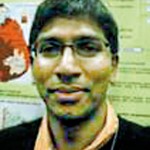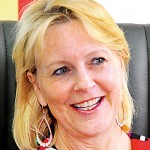News
Dengue in Sri Lanka primarily of one strain, research and facts reveal
Facts backed by research on the dengue-front are coming up slowly but surely.
The facts are indisputable. Since 2011, Sri Lanka has seen the dengue-scene dominated by the strain, Serotype 1, and to a lesser extent Serotype 4.
Why is one serotype showing such dominance for such a long time? While answers are being awaited, Prof. Annelies Wilder-Smith of the University of Umea, Sweden, who was in Sri Lanka for intensive consultations on this virus recently, briefed the Sunday Times on what has been happening behind the public eye on dealing with this disease.

Dr. Hasitha Tissera
Prof. Wilder-Smith is the Coordinator of ‘DengueTools’ which is one of three prongs of a major funding exercise by the European Commission (EC). Launched in September 2011, this Euro 18 million initiative which is due to conclude in February 2016 also includes ‘IDAMS’ (International Research Consortium on Dengue Risk Assessment, Management and Surveillance) and ‘DENFREE’.
‘DengueTools’, ‘IDAMS’ and ‘DENFREE’ are three consortia engaging in dengue research, says Prof. Wilder-Smith, picking out the one relevant to Sri Lanka for more elaboration.
The important pillars of ‘DengueTools’ are dengue surveillance and novel tools to prevent dengue in school-age children in Sri Lanka, while also assessing the risk of dengue-introduction to Europe.
‘DengueTools’ is bringing together the expertise, skills and leadership of 14 partners — nine from Europe, four from Asia and one from South America – according to this expert. In Sri Lanka it is the Health Ministry’s Epidemiology Unit headed by Dr. Paba Palihawadana which is heavily involved while the other Asian countries which are part of the project are Thailand, Singapore and Malaysia. Brazil is the South American country.
The ‘DengueTools’ consortium consists of a talented group of experts, with skills ranging from epidemiology, economics, laboratory diagnostics, entomology, environmental science and mathematical modelling to clinical expertise. The Centre for Global Health Research at Umeå University is the coordinating institute, it is learnt.In Sri Lanka, the Principal Investigator of ‘DengueTools’ is Dr. Hasitha Tissera, Head of the National Dengue Control Programme.
Getting down to brass tacks, Prof. Wilder-Smith points out that with ‘DengueTools’ going full steam ahead from March 2012, the laboratory facilities for dengue-testing at the Medical Research Institute (MRI) have been strengthened and capacity-building of the staff carried out.
The sentinel surveillance sites picked under the project are the Lady Ridgeway Hospital for Children in Colombo, the Infectious Diseases Hospital in Angoda and the Homagama Hospital as well as the outpatient clinics of two General Practitioners, all in the Colombo district. Point-of-care tests to check patients at the time of first presentation to these sites have been carried out, she said.This is ‘passive’ surveillance, the Sunday

Prof. Annelies Wilder-Smith. Pic by Mangala Weerasekara
Times learns, while ‘active’ surveillance has taken the form of studying 1,500 households in Ward 33 of the Colombo Municipal Council. Health officials have ventured into the community to perform blood pricks to find atypical dengue or milder dengue in adults and children.
“Two rounds have already been done and the final round is due next year,” explains Prof. Wilder-Smith, adding that nearly 5,000 samples have been collected from both the health sites and the community and the data are being looked at.
In the first year, there was double-testing of the diagnostic assays at Sri Lanka’s MRI and Singapore’s Duke-NUS University which also carried out further sequencing which requires highly sophisticated methods and expertise. This also helped to encourage collaboration, she says, adding that Sweden was involved in data management, validation and refinement.
The interim findings indicate that 80% were positive for Dengue Serotype 1 and 20% for Serotype 4. This is a long time for one serotype to dominate, she says, adding that why it has been so has to be checked out.
Prof. Wilder-Smith is excited about the prospects for dengue prevention and management in Sri Lanka with the high-level commitment which has happened “inadvertently”. In 2013, when discussions were held with the Health Ministry, the then Minister was Maithripala Sirisena who has now been elected the President of the country. Even in 2013, it was in Sri Lanka that there was most exposure with government. Therefore, dengue has a high profile and this helps translate results into action and leads to evidence-informed policy making, she adds.
Once ‘DengueTools’ draws to an end next year (2016), the results will be shared with Sri Lanka, through extensive discussions with policy makers.
Pointing out that a multi-pronged approach is essential to fight dengue, Prof. Wilder-Smith says that the only component missing is the vaccine. Dengue is proving itself to be very complex and is poised to increase as urbanisation poses higher risks.
Citing the example of Singapore, she asks why this State which is so modern cannot contain dengue. The vital need is to study urbanisation as the main driver of dengue and have prevention programmes going beyond health to better urban planning. So there is an urgent need to re-think dengue in the development context.
| Dengue spread by travel: Prof. Wilder-SmithIt was not there before, but it is there now. The first-ever cases of dengue in Europe were reported in 2010 in France and Croatia and they were not ‘imported’, explains Prof. Wilder-Smith, pointing out that the virus had been introduced via travel. This is what helped to turn the attention of the EU to dengue and led to the funding of the consortia. There followed a major dengue-outbreak in Portuguese Madeira in 2012. The 2,000 cases of dengue on a small island shocked Europe which then focused on the control of this disease, she adds. Tackling dengue in ‘built’ environment needs paradigm shift “There is an urgent need for a paradigm shift in tackling dengue. Urban planners need to work closely with the health authorities,” reiterated the Head of the National Dengue Control Programme, Dr. Hasitha Tissera, echoing the views of Prof. Wilder-Smith. Professionals need to work together to translate the growing understanding of the link between the ‘built’ environment and health, he said, defining the built environment as all buildings, spaces and products created or modified by people.According to Dr. Tissera the built environment affects the health and quality of life of the people. With the emergence of the collective recognition of the built environment as an essential health setting, there is a need for a pragmatic approach among professionals, for dengue is being seen as the proxy of financial and social wellbeing. |

